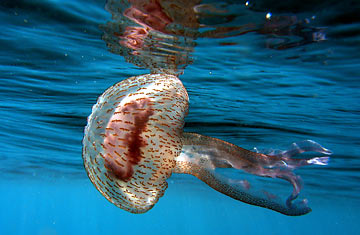
A medusa jellyfish floats in the sea near the Adriatic town of Split, Croatia
The swimming of a single jellyfish generates barely a ripple in the world's vast oceans. But what about a bloom of thousands of the creatures? Moving together, could they contribute to the large-scale mixing of ocean waters — the way the winds and tides do — as some scientist have long conjectured?
Kakani Katija, a graduate student at the California Institute of Technology, believes it's possible, based on her recent experiments with jellyfish blooms in a freshwater lake in Palau. Using high-powered underwater lasers and video cameras, Katija and her team studied how the movement of jellyfish impacts the water around them. Researchers placed a fluorescent dye in front of the jellyfish and observed what happened as the jellyfish swam through it. To their surprise, rather than swimming through the dye, the jellyfish appeared to pick it up, tucking it in a space just behind their tentacles. As the jellyfish swam, they carried the dye (and water) along. By monitoring the variation of the dye color, the research team discovered that each jellyfish was carrying water for about 50 feet (15 meters) — many times the size of its body.
"A high-pressure field is created in front of the body, and a low-pressure field is created at the back of the body," explains Katija, and the low-pressure acts like a vacuum, sucking in the nearby water when the jellyfish begins to move. "What we have found is a mechanism that would allow for animals to mix water efficiently when they swim."
The new research, published in the journal Nature, would suggest that the mass movement of marine animals — even tiny zooplankton like krill — may play a significant role in churning the ocean. It may help mix cooler water with warm, and disperse salts, nutrients and pollutants across the various layers of the ocean, which is critical to the strength of ocean currents and the health of the marine ecosystems. Although ocean-mixing is largely attributed to winds and ocean tides, scientists say those factors cannot account for all the energy required to power, for example, the complete circulation of cold and warm water between the earth's poles and equator. The authors of the Nature paper write that marine activity of the kind they describe may be a "significant contributor to ocean-mixing and nutrient transport."
But oceanographers familiar with the subject say research into ocean-mixing is only just beginning and that it's too early to make such assertions. "I appreciate what they [the Caltech team] are saying, but taking experiments of one particular event and extrapolating it to a global scale is always problematic," says oceanographer Andre Visser of the Technical University of Denmark.
In one study published in the journal Science in 2006, a group of scientists reported that they had recorded enormous water turbulence in a fjord in Canada caused by a swarm of swimming krill. These tiny shrimplike organisms have a predictable up-and-down movement: during the day, they descend several hundred feet in the ocean, where there is less light and fewer predators; as the sun sets, they swim up to the surface to feed. Swarms of krill can be massive — some the size of Rhode Island — so oceanographers have suspected that their movements may cause significant ocean-mixing. But despite numerous attempts, the phenomenon has not been observed since the 2006 study. "Instead, many people studying mixing have not seen large increases in mixing during times krill or other zooplankton migrate," says Michael Gregg, an oceanographer at the University of Washington.
For his part, Gregg is hoping to study mixing by following fishing trawlers, since good fishing grounds are usually the places with lots of ocean churn. Meanwhile immense blooms of jellyfish — of the kind that Katija studied — are drawing the attention of other scientists and policymakers. Such blooms, thousands strong, are becoming increasingly common worldwide, in part due to the overfishing of jellyfish's natural predators, including anchovies, sardines and herring. In the Sea of Japan, for example, the nomura, jellyfish that grow up to 6.5 ft. (2 m) in diameter and weigh more than 400 lbs. (180 kg), have proliferated, and a recent study by Hiroshima University researchers has warned that another big bloom is expected this summer.
Whether or not they contribute to ocean-mixing, it's clear that mushrooming swarms of jellyfish can threaten marine ecosystems by competing with native fish, spread aquatic parasites and contaminate commercial-fishing catches. We could be very close to a stage where parts of the ocean "go from being dominated by fish to being dominated by jellyfish," says marine ecologist Anthony Richardson of the University of Queensland in Australia. "And once we're on this jellyfish joyride, it is extremely difficult to get off."
